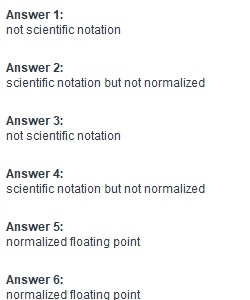


Q Question 1 0.6 / 0.6 pts For each expression of decimal floating point below, choose the best form of the expression from the dropdown list. • 30.15×10?5 is ["", "", ""] • 0.15×101 is ["", "", ""] • 105 is ["", "", ""] • 0.001×10?20 is ["", "", ""] • 1.88×1029 is ["", "", ""] • 4.33e?100 is ["", "", ""] Question 2 0.2 / 0.2 pts Which of the following is the math formula that calculates the decimal equivalent of a single-precision floating point? Choose ONE. Fill the letter code in the box. A. 1s×(1+F)×2E B. (?1)s×F×2E?255 C. (?1)s×(1×F)×2E?127 D. (?1)s×(1+F)×2E?127 PartialQuestion 3 3 / 3.6 pts Consider bit pattern 0xB56A 4000. Fill out the blanks to calculate the decimal equivalent of the pattern if it is treated as a single-precision floating point. Step 1: The sign bit s = . Step 2: Calculate the exponent E by following 2a and 2b. • 2a: Extract the exponent to the following positional notation. No need to write subscript. Position 7 down to 4 3 down to 0 Bit • 2b: Calculate the decimal equivalent by completing the addition. E = 1 × 2^ + 1 × 2^ + 1 × 2^ + 1 × 2^ + = • o ? Fill each blank with the exponent of a power of 2 in ascending order by the exponents. Step 3: Calculate the fraction F. • 3a: Extract the exponent to the following table (NOT positional notation) Re-pos. 1 to 4 5 to 8 9 to 12 13 to 16 17 to 20 21 to 23 Bit 0000 0000 000 • 3b: Done in 3a. • 3c: Calculate the value held by fraction bits. F = 1×2^( ) + 1×2^( ) + 1×2^( ) + 1×2^( ) + 1×2^( ) = (answer in 4-significant-digit normalized scientific notation using e.) • o Arrange the exponents in descending order. Step 4: Plug the values in the formula (-1)s × (1 + F) × 2E ? 127 = . • Answer in 4-significant-digit normalized scientific notation using e. PartialQuestion 4 3.2 / 3.6 pts Consider bit pattern 0xD90D 5000. Fill out the blanks to calculate the decimal equivalent of the pattern if it is treated as a single-precision floating point. Step 1: The sign bit s = . Step 2: Calculate the exponent E by following 2a and 2b. • 2a: Extract the exponent to the following positional notation. No need to write subscript. Position 7 down to 4 3 down to 0 Bit • 2b: Calculate the decimal equivalent by completing the addition. E = 1 × 2^ + 1 × 2^ + 1 × 2^ + 1 × 2^ + = • o ? Fill each blank with the exponent of a power of 2 in ascending order by the exponents. Step 3: Calculate the fraction F. • 3a: Extract the exponent to the following table (NOT positional notation) Re-pos. 1 to 4 5 to 8 9 to 12 13 to 16 17 to 20 21 to 23 Bit 0000 0000 000 • 3b: Done in 3a. • 3c: Calculate the value held by fraction bits. F = 1×2^( ) + 1×2^( ) + 1×2^( ) + 1×2^( ) + 1×2^( ) = (answer in 4-significant-digit normalized scientific notation using e.) • o Arrange the exponents in descending order. Step 4: Plug the values in the formula (-1)s × (1 + F) × 2E ? 127 = . • Answer in 4-significant-digit normalized scientific notation using e.
View Related Questions